 Never underestimate the importance of food, ritual and the power of community. Care for one another and the planet by taking part in food sharing or starting a food sharing club in your workplace, social circle and/or community.
Never underestimate the importance of food, ritual and the power of community. Care for one another and the planet by taking part in food sharing or starting a food sharing club in your workplace, social circle and/or community.
Five reasons to take part in food sharing
Participating in food sharing or starting a food sharing club with your workplace, social circle and/or community has many economic, social and wellbeing benefits.
1. Encourages healthy eating
Participants are exposed to various types of cuisine and cooking styles and share knowledge. This can inspire people to incorporate more nutritious foods into their diets and adopt healthier eating habits.
2. Reduces waste
Food sharing clubs and practices reduce food and packaging waste by economizing portions, purchasing in bulk, encouraging cooking from scratch, and sharing and redistributing surpluses.
3. Supports food security
Food sharing clubs and practices bolster local food security by emphasizing nutritious locally available food, making meals affordable and regularly accessible, and fostering community connection and resilience.
4. Supports wellbeing and sharing economies
A wellbeing economy puts quality of human life and the health of the planet first, bridging the economy, environment and social justice. In a sharing economy, goods and services are communally distributed. Food sharing clubs and practices align with and support these core values.
5. Builds connections, creates belonging and provides opportunities to learn about each other
Sharing meals or participating in food-related activities can reduce isolation and strengthen bonds between people and their communities. Food sharing clubs and practices also serve as sources of support, friendship and collaboration — providing in-person social networks where people can connect with others who share similar interests and values or build bridges between their differences, such as age, culture, socioeconomic status or more. They play a valuable role in building stronger, more resilient communities.
Cultural food sharing practices
Sharing food is deeply rooted in many — perhaps all — cultures, through traditions, social norms and values, transcending borders and bridging generations. Though food sharing practices vary widely, giving and receiving food often symbolizes kinship and reciprocity, strengthens social and familial bonds and celebrates cultural identity.
Examples of cultural food sharing customs
- China. The Cantonese tradition dim sum means “to touch your heart.” Sharing small plates of steamed, fried and baked offerings with loved ones touches tastebuds too!
- Mediterranean and Middle East. Mezze, which originates from the Farsi word for “taste” or “relish,” is a traditional style of communal dining in many Mediterranean and Middle Eastern cultures where an assortment of small plates is shared, often as appetizers.
- Philippines. Kamayan translates to “hands” in Tagalog and describes a communal feast often served on banana leaves.
- Ethiopia. Beyaynetu is a style of Ethiopian communal eating. A platter featuring various stews is shared using injera, a sourdough flatbread, to scoop up the stew.
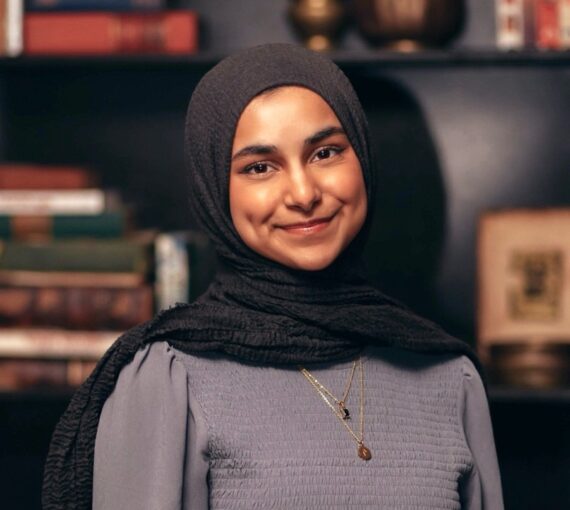
Personal anecdote from David Suzuki Foundation staff
“Ramadan is a holy month for Muslims around the world and is an opportunity to fast, reflect and build community.
“A most cherished ritual during Ramadan is iftar, the breaking of fast at sunset. The kitchen becomes a bustling hub where everyone has a role. Making and sharing food creates a sense of togetherness.
“Preparing extra portions to distribute to neighbours, regardless of faith, is a gesture of goodwill and care. This tradition breaks down pre-conceived notions, builds friendships and spreads joy and warmth within the community. It’s a reminder of the common humanity and generosity that lies at the heart of Ramadan.
“Through these food sharing rituals and practices, food becomes more than sustenance; it becomes a means of building community, understanding and compassion. It’s a time when the act of sharing a meal can open hearts and minds, bring communities closer together, while also supporting and uplifting their members.
“In essence, Ramadan teaches us that sharing food is not just about feeding the body but also about nourishing the soul and the bonds that connect us all.”
Meshall Awan, Communication Specialist for Sustainable Communities
Indigenous food sharing customs in the Pacific Northwest
Potlatch is an important traditional ceremony to Pacific coastal Indigenous groups (such as the Kwakwaka’wakw, Nuu-chah-nulth and Coast Salish). Potlatch means “to give” and is derived from Chinook trade jargon. The ceremonial gift-giving feast is a cornerstone of Indigenous social, economic and spiritual life. It’s an important method of preserving and sharing history, reinforcing community bonds, redistributing wealth and affirming cultural identity.
In 1884, the government decided potlaches were hindering its ability to assimilate Indigenous people and were banned the practice until 1951. The ban underscored the vital role that food sharing plays in shaping and sustaining cultural identity, resilience and resistance within Indigenous communities. Today potlatches are held to honour important people in the community or the passing of an elder.
Eight ways to build community through food sharing
Sharing can be a powerful conduit for connection. Integrate your cultural food sharing traditions, elements and themes (e.g., cuisine, sharing style, etc.) into your food sharing club or practice.
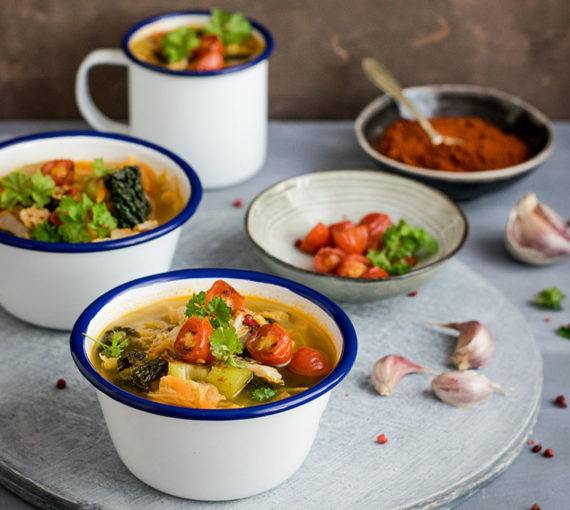
Start a soup, salad or sandwich club
Perfect for a workplace — but great to try with family, friends or neighbours, too! Can a pot of homemade soup, bowl of salad or DIY sandwich bar save the planet? No. But here’s what it can do (use these tips to help with your pitch):
Benefits:
- Cheap, delicious, nutritious meals.
- Boosts productivity. Take back the lunch break and don’t eat at your desk. You’ll return to work refuelled, refocused, re-energized and relaxed.
- A great way to introduce colleagues to your workplace green team or a launching point to start one.
- Transition between the three club styles with the seasons: sandwich club in the fall, soup club in the winter and salad club in the spring/summer.
- Less waste. No plastic takeout containers!
- Incentive to plant a garden. Impress your colleagues by growing your own fruits, veggies and edible perennial plants.
- Get creative with leftovers. Make a delicious soup stock, salad dressing or sandwich fixings with upcycled food trimmings and scraps.
- Try new recipes. Cater to the dietary needs of members, e.g., vegetarian, vegan, gluten-free, etc. For the planet, emphasize organic, local, seasonal ingredients, maybe from peoples’ gardens.
How it works:
Soup club: People take turns bringing in a communal-sized pot of soup and crackers or bread to share.
Salad club: People take turns bringing greens and homemade or store-bought dressing. On club day, everyone else brings one topping to share e.g., olives, cheese, fresh herbs, chickpeas, etc.
Sandwich club: People take turns bringing bread. On club day, everyone brings one ingredient to share e.g., protein, spreads, veggies, pickles, etc.
Circulate a sign-up sheet with dates (e.g., every Wednesday at noon) and a row for names. Start a group chat with participants. If people forget or can’t make it last minute, group members can self-manage and substitute.

Start a food circle
A food circle is a great way to help a family member, co-worker and/or neighbour, the best baby shower gift ever and a kindness for someone going through health challenges or grieving a loss.
Benefits:
- Nutritious, healthy meals cooked with love.
- No pressure for recipient to shop or cook.
- No expectations to visit or play host.
- A chance to introduce the recipient to new dishes.
How it works:
- There is no “right” way! Always ask first: Would it be helpful? Are there dietary restrictions? Check in with recipients to make sure they have what they need.
- Designate someone as the “food circle coordinator.”
- Collect food givers’ email addresses or phone numbers — maybe post or circulate a sign-up sheet and make a shareable calendar. (There are online platforms that can help.)
- Suggest volunteers prepare dishes that freeze easily, such as veggie chili and lasagna, quiche, soups and stews. Washed, chopped and ready-to-eat fresh organic, local fruit and veggies may be a welcome treat too. Coordinate or make meal suggestions so the recipient isn’t eating casserole for weeks.
- Pack food in reusable containers like recycled glass jars, stainless steel, etc.
- Schedule food drop-offs. Does the recipient prefer daily or weekly? Someone with freezer space who lives near the recipient can volunteer to be the drop-off depot. Or people can make their own deliveries — just confirm the appropriate day and time for the recipient.
- Thank volunteers!

Start a dinner party club
Bring friends, neighbours or the people you live with together to enjoy food and company on a regular basis by starting a dinner party club.
Benefits:
- Deepens community relationships.
- Can be an exciting add-on to an existing community group like a book or movie club.
- Encourages members to step out of their culinary comfort zones.
- Can centre on a theme. For example: A “waste-free wine and dine” featuring organic, biodynamic, natural and vegan wines and waste-free food dishes. Or a “farm-to-table feast” featuring only locally sourced, seasonal, organic ingredients.
- Opportunity for planet-friendly event hosting skills.
- The group can decide to make each dinner potluck or require each person to sign up for a turn to provide food.
How it works:
- Identify potential members who share common interest in food and community building.
- Determine how often you want to all meet, e.g., weekly, monthly, bi-monthly, seasonally, etc.
- Decide on logistics, including location, time and duration. Try rotating hosting responsibilities or choose a central location that everyone can easily access. Or eat alfresco — host outdoors on a patio or in a local park or green space, weather permitting.
- Establish guidelines to ensure all members are aware of dietary restrictions, attendance expectations, hosting duties, theme information and other details. Set up a group chat, email list or social media group.
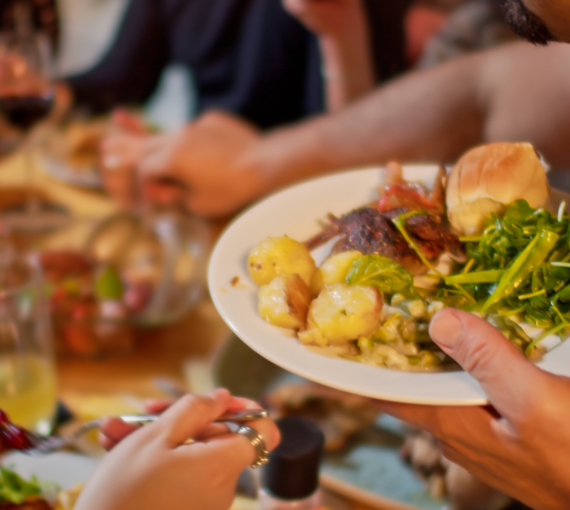
Host a potluck
A crowd favourite and classic for gatherings and social events!
Benefits:
- Potlucks bring together a variety of dishes, often reflecting members’ diverse tastes and culinary skills.
- The workload is shared, alleviating pressure on the host to prepare an entire meal.
- Can be an exciting add-on to an existing community group like book or movie club.
- The group can decide to centre each potluck on themes that encourage sharing and connecting, e.g., each member brings a dish from their cultural heritage or their favourite dish as a child.
- Can be organized ad hoc (celebrations, events, etc.) or regularly.
- Leftovers can be shared or taken home, reducing food waste and ensuring all remaining dishes are enjoyed rather than discarded.
How it works:
Follow the same steps for “Start a dinner party club” and modify as needed. To avoid too much of one thing, designate contributions into categories, e.g., proteins, sides, salads, desserts, etc.
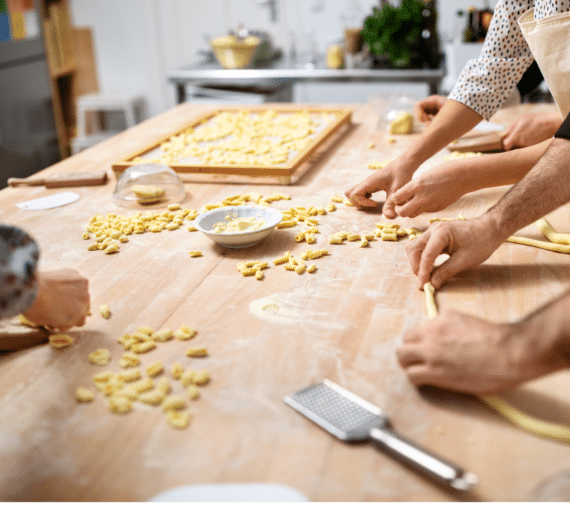
Host a cooking workshop or skills swap
Want to brush up your cooking skills? Share culinary skills with others? Hosting a cooking workshop or skills swap is a great way to build community through knowledge exchange.
Benefits:
- Provides opportunities to learn new culinary techniques, recipes and cooking methods.
- Members can share culinary expertise and experiences, fostering a collaborative learning environment. People benefit from diverse perspectives and cooking traditions.
- Workshops encourage creativity and experimentation with ingredients, flavours and techniques.
- Promotes cross-cultural and intergenerational appreciation and understanding.
- Can be used as a payment in kind. Instead of exchanging money for learning a new skill, you share a skill — contributing to the sharing economy!
How it works:
- Identify potential participants who share interest in building culinary skills and/or are willing to share skills.
- Organizers choose specific themes or topics, e.g., cooking with cast iron, knife skills, plant-based cooking, etc. Circulate a sign-up sheet or online poll so participants can share their availability, if they’re willing to host and what skills they’re looking to learn and share.
- Choose a time, date and location for the first few workshops. If no one is willing and able to share their kitchen for hosting, consider renting a community kitchen. (Check your municipality’s website for publicly accessible kitchens.)
- Ask workshop leaders to provide a list of supplies, equipment and/or ingredients. Arrange for participants or the host to bring these.
- Solicit feedback at the end of the workshop so you can strengthen future iterations.
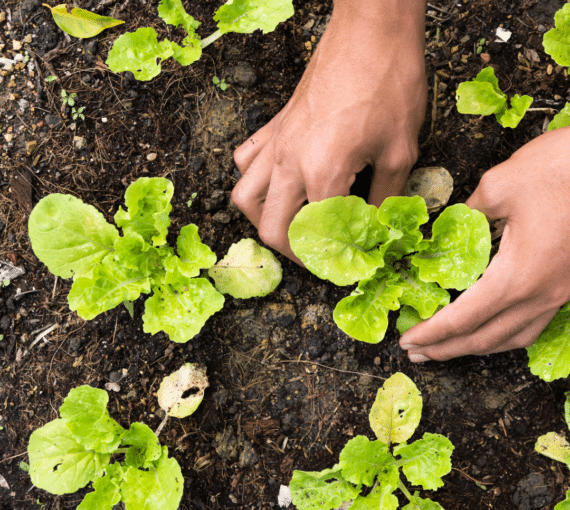
Donate your land to local food growers
Got unused land? A garden plot you don’t have time to tend? Donate your land to local food growers and small-scale farmers!
Donating your land to food growers is a meaningful contribution to food security, sustainable agriculture and community development.
Benefits:
- Contributes to local food security by increasing access to fresh, locally grown produce.
- Fosters community engagement and empowerment by creating opportunities for individuals and groups to take part in food growing and sharing activities, educational programs and social gatherings.
- Supports sustainable agricultural practices like preserving soil health and biodiversity and conserving water.
- Access to green spaces and gardening activities have been linked to improved physical health, mental wellbeing and social cohesion.
- Donated land can be a platform for education, training and skill development in organic farming, permaculture and environmental stewardship.
- For aspiring farmers or food growers, access to land can create economic opportunities through the sale of produce or value-added products, e.g., jam made from wild strawberries.
How to find food growers in your community:
- Look for community farm programs that connect growers with land.
- Check if your province has a land matching program. For example, the British Columbia Land Matching Program “provides personalized land matching and business support services to farmers looking for land to start or expand their farm, and landholders interested in finding someone to farm their land.”
- Connect with your local community garden for advice. It may be able to connect you with vetted individuals or organizations.
- If you have fruit trees, look for organizations or projects that help harvest them and provide surplus yield to community members who have reduced access to fresh produce (e.g., Vancouver Fruit Tree Project).
- Research local urban farming initiatives and non-profit organizations focused on community food security. They may benefit from access to land for workshops.
- Post a bulletin in a community space (e.g., community centre, local café, etc.) or neighbourhood social media group.
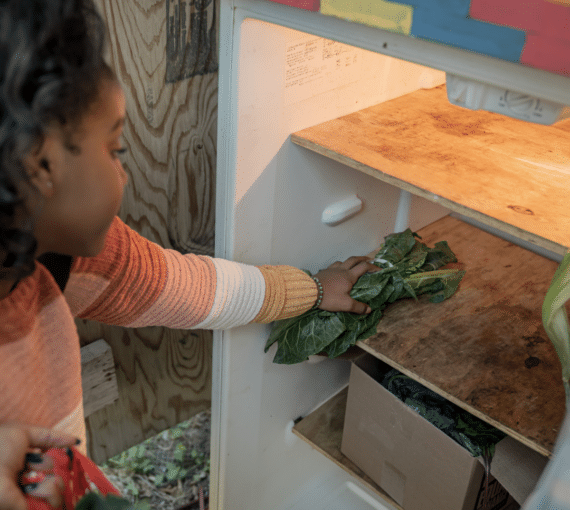
Support local food initiatives
Bring your food sharing practices and values into your community by supporting food initiatives. You’ll empower local solutions to food insecurity, contribute to food system resilience and expand your community network!
Benefits:
- Reduces food waste by redistributing and redirecting surplus food.
- Supports food insecure individuals and families by offering access to nutritious food at little or no cost.
- Empowers local solutions. Many food initiatives are grassroots efforts driven by community members passionate about food security and social justice. Communities can take ownership of their food systems and work toward sustainable, community-driven solutions.
- Advocates for system change. Many local food initiatives serve as platforms for advocacy and awareness-building around broader issues related to food security, poverty and social inequality. They can amplify voices of marginalized communities and advocate for systemic changes to the root causes of hunger and food injustice.
Potential local food initiatives:
- Donate to community fridges. Search online for projects in your neighbourhood. Typically, these accept fresh fruits and vegetables, non-perishable items, dairy products (even after best before date), beverages and home-cooked food (labelled with ingredients and date made).
- Volunteer at a community kitchen, senior centre or shelter.
- Donate to your local food bank.
- Join a community co-op — member-owned grocery stores that prioritize local, organic food.
- Participate in local food rescue programs. Check if restaurants and grocery stores in your community donate excess food. Look for mobile apps that enable these programs.
- Volunteer with food recovery programs that collect surplus food from businesses, farms and other sources and distribute to those in need. You can help collect, sort and distribute.
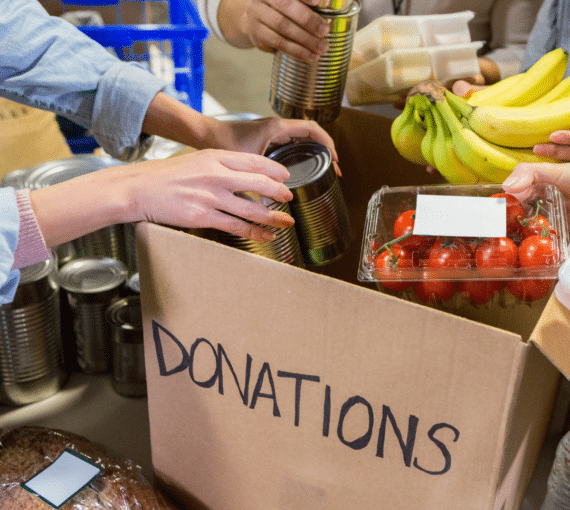
Participate in the free economy
The free economy (a.k.a. “the gift economy”) is predicated on the principles of sharing, generosity and reciprocity. Foods, services and resources are exchanged without money or formal transactions. Instead, participants give and receive freely, often motivated by a sense of community, solidarity and mutual support.
Benefits:
- Fosters social connections.
- Reduces consumerism and food waste.
- Food sharing in the free economy empowers people to help address food insecurity and build community resilience.
- Supports mutual aid and collective action.
- Saves money. Instead of buying a food you need, you can trade for it with something you already have but don’t need.
- Promotes low-impact lifestyles.
Ways to participate in the free economy:
- Join or start a local Buy Nothing group or Free [neighbourhood name] group. Organize it through social media, email or a group chat. Post excess food for neighbours to swap or collect.
- Trade excess food for other food and/or goods in online marketplaces.
- Attend or organize a local food swap.
- Attend free community meals put on by organizations that use surplus food (e.g., Food Not Bombs).



